RAF KHORMAKSAR
Re Beihan - I remember we used to buy quite brightly coloured rugs dyed with vegetable dyes in Beihan..
Does anyone remember Beihan ‘chairs’ ? As I recall, although it was fifty odd years ago, a Beihan chair was a kind of circular belt thing that you wrapped round your nether regions and your knees and which enabled you to sort of squat without falling over.
Does anyone remember Beihan ‘chairs’ ? As I recall, although it was fifty odd years ago, a Beihan chair was a kind of circular belt thing that you wrapped round your nether regions and your knees and which enabled you to sort of squat without falling over.
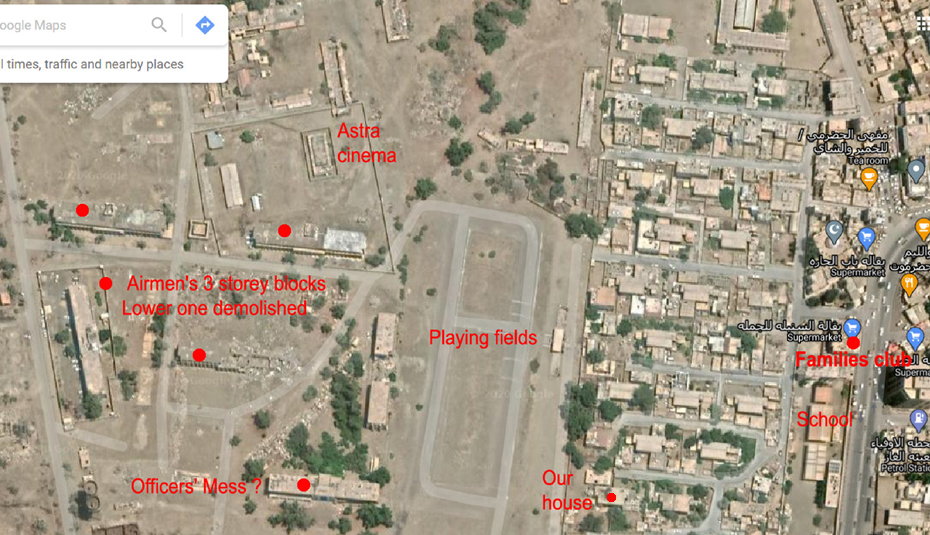
Courtesy Google earth, here is Khormaksar as it is this year. The runway 08-26 runs above the top edge of the picture but the hangars and RAF buildings look to be in ruins. The three barrack blocks are quite distinctive and the east half of the lower one has been demolished. In the early 1950s roads and I think the runway were packed gypsum.
These AMQ semis with their cool verandahs front and rear and kitchen built onto one end seem to be little changed, and the Patch road layout is unchanged although buildings cover what I remember as acres of desert. The Families' Club is now a supermarket, across the Sheikothman Road are more married quarters but I can't remember their layout and even the former Aden Protectorate Levy lines have been redeveloped.
I'm quite pleased to find that 167W, our house in the corner of the Patch is still standing almost 70 years since I first saw it. I wonder if anyone remembers our Brigand pilot neighbour F/Sgt Cramp in 167E?

Officers' Mess Khormaksar
Geriaviator
IIRC the Mess is a little to the South of your mark. In the centre in front of the buildings (south) you can make out the ruins of the Jungle Bar where many a good night was to be had. Very sad to see as it brings back some fine memories. (N12.817877 E045.030029).
Scars on the ground where the old air-conditioned accommodation was situated, just 50yds to the north of the West Wing. That was luxurious living but you had to wait for it, in my case 6 months.
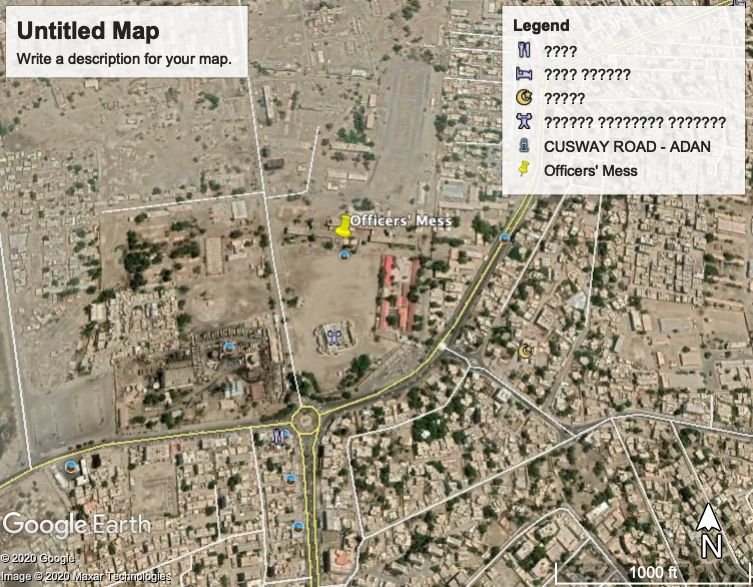
IIRC the Mess is a little to the South of your mark. In the centre in front of the buildings (south) you can make out the ruins of the Jungle Bar where many a good night was to be had. Very sad to see as it brings back some fine memories. (N12.817877 E045.030029).
Scars on the ground where the old air-conditioned accommodation was situated, just 50yds to the north of the West Wing. That was luxurious living but you had to wait for it, in my case 6 months.

Thanks Deano, your nav is better than mine, I had another look at my photo #775 which shows the OM quite clearly. The development in 70 years is amazing, I recall nothing east of the camp except the APL lines but the 2020 satellite view shows it packed tight with property.
School ended at lunchtime and when our parents couldn't/wouldn't stump up the shilling fare for the Bedford QL gharri to Steamer Point lido we took the one-mile track to the camp pool on the fantastic beach along the east side of the Aden peninsula. Pool has long gone and beach is now the Layali Dubai Tourist Park. Station standing orders decreed that personnel and families should not swim off the beach which was home to shark, sting ray, barracuda and venomous sea snakes, but we did.
On the way back we could wander into the civil airport to inspect transit BOAC Argonauts, Hermes and beautiful TWA Constellations, together with Daks operated by Aden Airways and Ethiopian Air Lines. There was no taxiway so no time was wasted on backtracking, with a burst of outboard the Daks spun round in front of the RAF hangars and lifted the tail for their trip back to the civvy apron. We once found a friendly baby camel wandering near the pool and took it home with a view to keeping it on the back verandah but our parents wouldn't allow it.
Who needed Facebook, Instagram or TikTok? The height of excitement for me was the rare Saturday morning parked beside a Brigand with a bowl of petrol, a couple of brushes and 72 plugs from its Bristol Centauri. Today this would be considered dangerous child exploitation leading to lasting trauma in adulthood which probably explains a lot …
Only aircon we knew was when my dad pinched the cooling trolley used to lower aircraft temps before departure and ran its long hose into the flight offices. I suppose we became accustomed to the heat; the houses were well designed and are still doing their job today. Inside we slept on a charpoy, the wooden frame strung with rattan netting, just as we had in India four years before. To avoid company at night we sometimes stood the legs in Players 50-cigs tins part filled with paraffin which deterred the ants and the few cockroaches which escaped Ahmed, my pet land crab.
I see Aden's average temp is around 32C with humidity 70%. People pay good money to obtain higher temps than this in Spain, Turkey or Greece, too hot for me so if lockdown ends we'll maybe try the Layali Dubai Tourist Park, doesn't seem too busy at present
School ended at lunchtime and when our parents couldn't/wouldn't stump up the shilling fare for the Bedford QL gharri to Steamer Point lido we took the one-mile track to the camp pool on the fantastic beach along the east side of the Aden peninsula. Pool has long gone and beach is now the Layali Dubai Tourist Park. Station standing orders decreed that personnel and families should not swim off the beach which was home to shark, sting ray, barracuda and venomous sea snakes, but we did.
On the way back we could wander into the civil airport to inspect transit BOAC Argonauts, Hermes and beautiful TWA Constellations, together with Daks operated by Aden Airways and Ethiopian Air Lines. There was no taxiway so no time was wasted on backtracking, with a burst of outboard the Daks spun round in front of the RAF hangars and lifted the tail for their trip back to the civvy apron. We once found a friendly baby camel wandering near the pool and took it home with a view to keeping it on the back verandah but our parents wouldn't allow it.
Who needed Facebook, Instagram or TikTok? The height of excitement for me was the rare Saturday morning parked beside a Brigand with a bowl of petrol, a couple of brushes and 72 plugs from its Bristol Centauri. Today this would be considered dangerous child exploitation leading to lasting trauma in adulthood which probably explains a lot …
Only aircon we knew was when my dad pinched the cooling trolley used to lower aircraft temps before departure and ran its long hose into the flight offices. I suppose we became accustomed to the heat; the houses were well designed and are still doing their job today. Inside we slept on a charpoy, the wooden frame strung with rattan netting, just as we had in India four years before. To avoid company at night we sometimes stood the legs in Players 50-cigs tins part filled with paraffin which deterred the ants and the few cockroaches which escaped Ahmed, my pet land crab.
I see Aden's average temp is around 32C with humidity 70%. People pay good money to obtain higher temps than this in Spain, Turkey or Greece, too hot for me so if lockdown ends we'll maybe try the Layali Dubai Tourist Park, doesn't seem too busy at present

Join Date: Mar 2010
Location: Often in Jersey, but mainly in the past.
Age: 79
Posts: 7,803
Received 135 Likes
on
63 Posts
My thanks to all contributors for fascinating stories and photos. I missed all these Arabian Nights, after a posting to somewhere (was it Salalah? Masirah?) was cancelled, so my ‘adventurous’ Overseas Tour had to be endured in the air-conditioned luxury of the O/Mess at Tengah.
Oh, what postings there were in those days! From my ATCO course at Shawbury, I remember one plt off went to El Adem. And several contemporaries enjoyed their time in assorted sandy places ... and Borneo. I feel a faint pang of guilt for not having served in any of those ‘less comfortable’ places. All I can claim is 4 months at Stanley in ‘83 and a couple of weeks in a tent up-country in Malaya in ‘69.
Oh, what postings there were in those days! From my ATCO course at Shawbury, I remember one plt off went to El Adem. And several contemporaries enjoyed their time in assorted sandy places ... and Borneo. I feel a faint pang of guilt for not having served in any of those ‘less comfortable’ places. All I can claim is 4 months at Stanley in ‘83 and a couple of weeks in a tent up-country in Malaya in ‘69.
Around Khormaksar in quieter times -1962/3
A few more photos of the area:
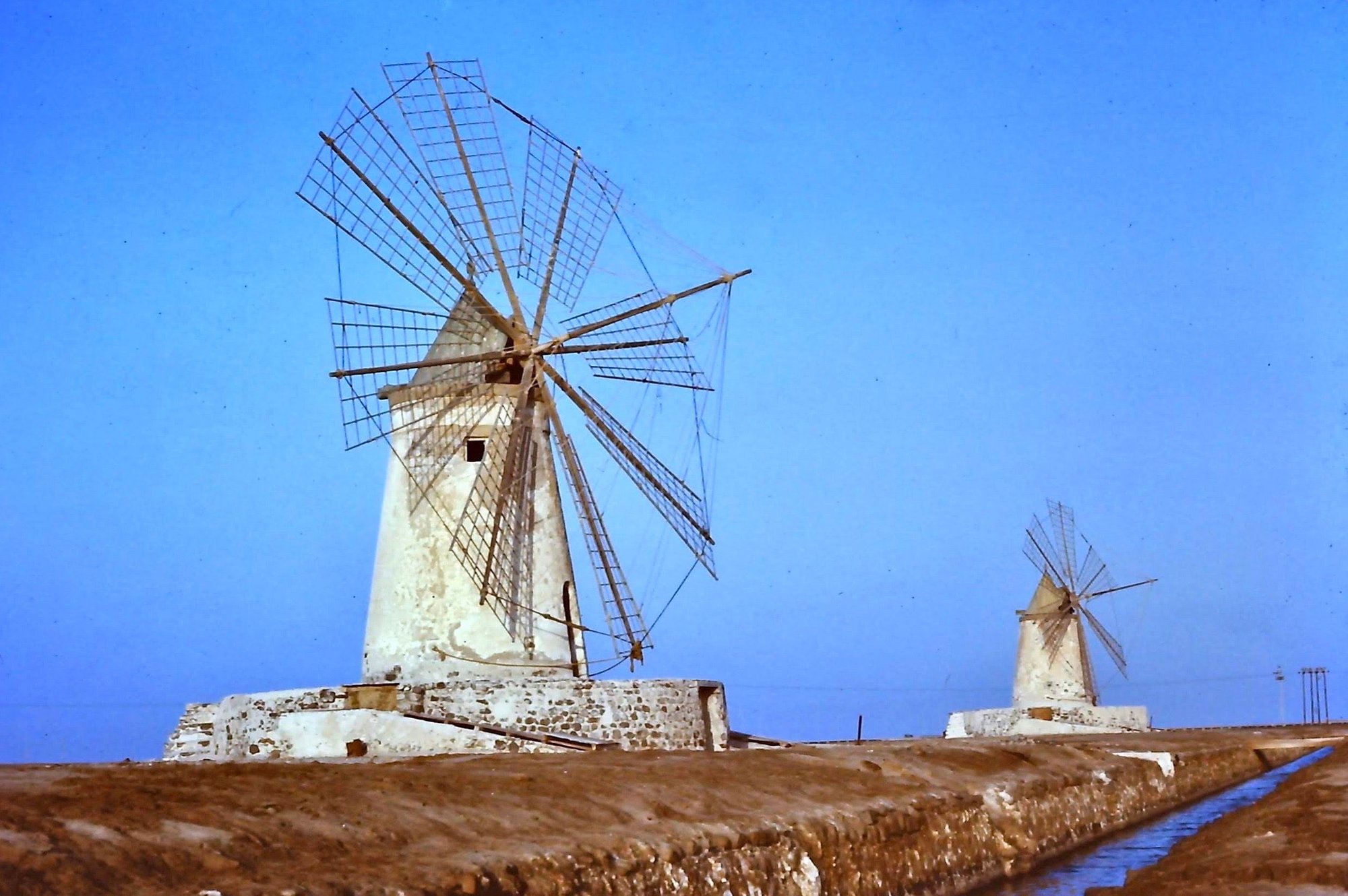
Windmills on salt pans to the North
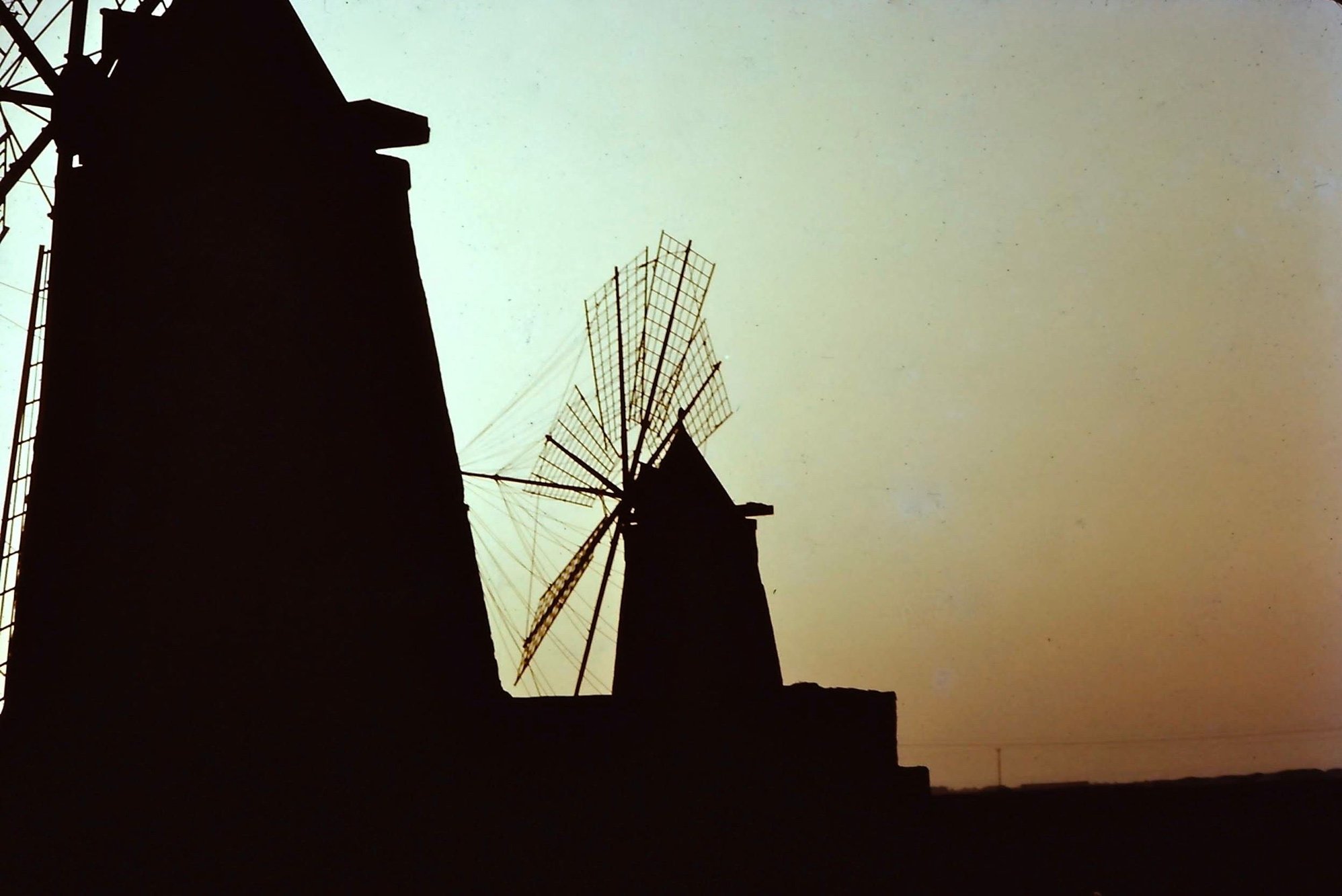
Windmills on salt pans to the North
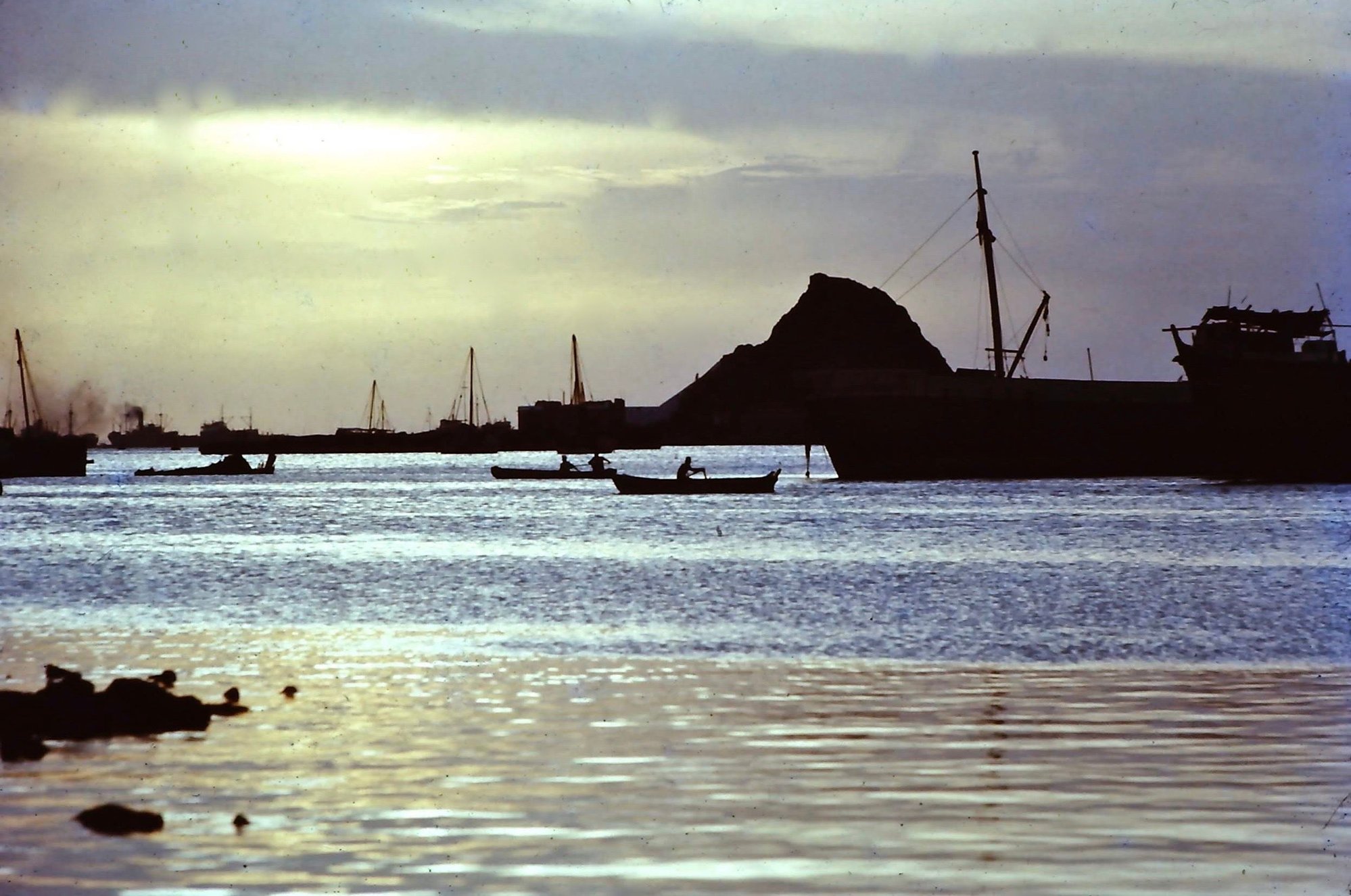
Harbour looking towards Steamer Point

Little Aden Oil Refinery with Mt. Shamsan in the distance
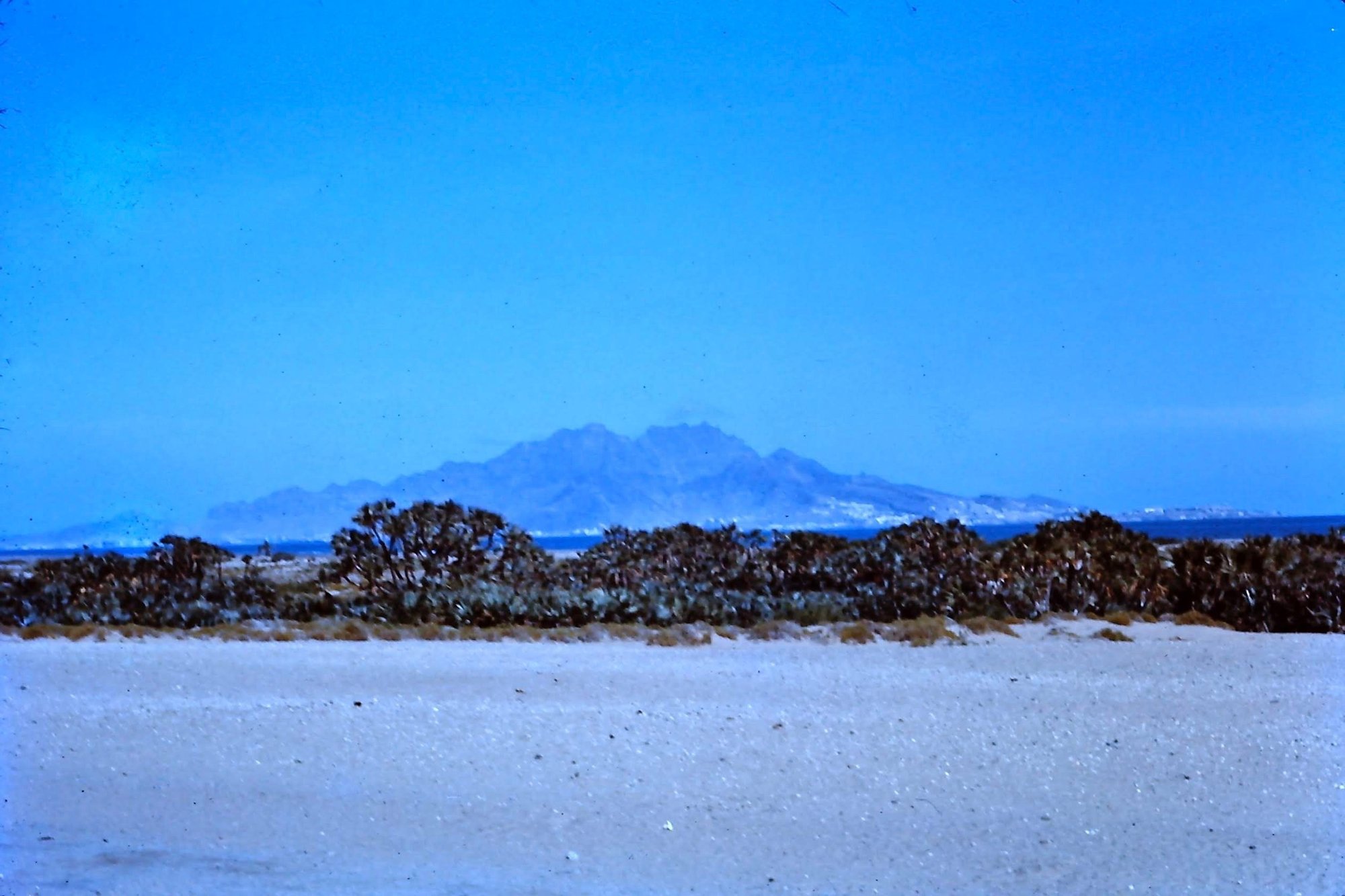
Looking back at Mt. Shamsan from the East en route to Little Aden

Windmills on salt pans to the North

Windmills on salt pans to the North

Harbour looking towards Steamer Point

Little Aden Oil Refinery with Mt. Shamsan in the distance

Looking back at Mt. Shamsan from the East en route to Little Aden
Photos taken en route to Lahej 1962
These photos were taken North of Khormaksar in 1962, when you could wander freely and safely on the road to Lahej.

My trusty Lambretta (Air conditioned). Purchased new and pristine but after 2 years covered in rust just like all the duty free cars that were bought and taken back to the UK.










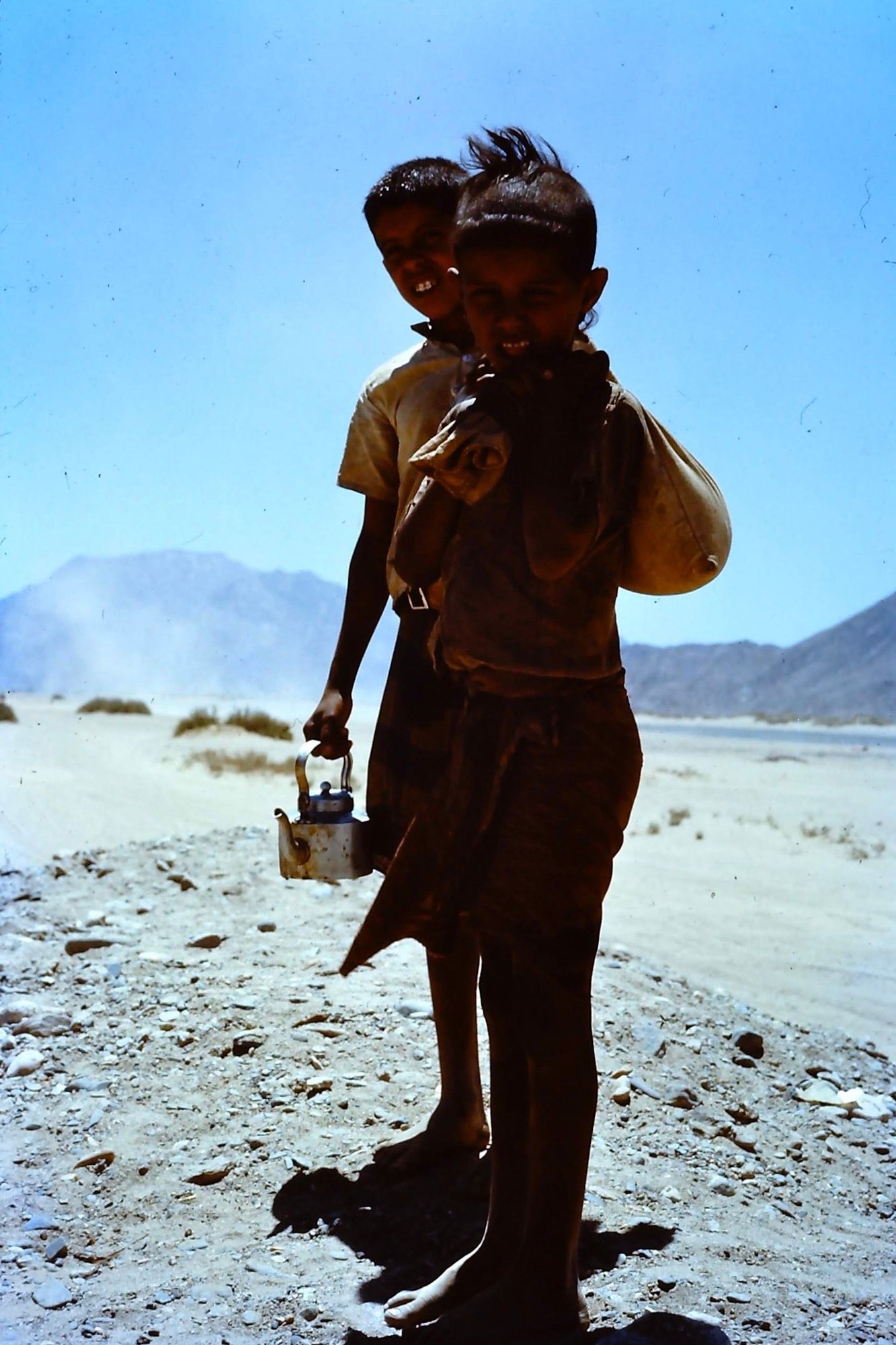

Aden mobile recycling programme - anything consumed

My trusty Lambretta (Air conditioned). Purchased new and pristine but after 2 years covered in rust just like all the duty free cars that were bought and taken back to the UK.












Aden mobile recycling programme - anything consumed
Not strictly K'sar. but very relevant to the area and its primary role activities, last Sunday's BBC R4 'Last Words' programme carried an obituary for James Nash, amongst other activities, one of the 'Political Officers' who roamed the 'up-country' Protectorate, providing liaison with the local rulers. They were all 'characters' and he, apparently, was among the more flamboyant. For those who know the area , well worth a listen.
Thanks Deano for the most atmospheric set of Aden photos I have seen, as I said earlier you have captured everything of that desolate place but the smells! Incidentally, during a stay in hospital a few years back my fellow patient Abdul was born in Steamer Point and left as a teenager in 1966 as the Arabs began expelling their British oppressors, oddly enough choosing to settle in the homeland of said oppressors. Normally very chatty he would not talk about the rebellion at all but spent ages poring through my old photos. I was intrigued that he pronounced Ah-den as in sad-den rather than Ay-den as we have always called it.
'Cornish Jack' - Whilst researching John Nash found this article
The Queen in Aden: a Jubilee Retrospective
In the year of Her Majesty Queen Elizabeth’s Diamond Jubilee, the following article recalls highlights of her visit to Aden in 1954. We are indebted to Dr Carol Downer for all but one of the b/w illustrations which accompany the text. These have been reproduced from the commemorative album belonging to her father, the late Air Marshal S.O. Bufton, who was closely involved with the Queen’s visit.Queen Elizabeth’s first pictorial association with Aden dates from June 1953 – the month and year of her coronation – when a new set of Aden colony stamps was issued bearing her profile surmounted by the Royal Crown. This issue was printed in East African currency (cents and shillings) which in 1951 had been adopted in place of the previously used Indian currency (annas and rupees). The stamps depicted a variety of local scenes, including the Colony’s emblematic dhow; and for the first time the toponym of Aden and the value of each stamp were printed in Arabic as well as in English.
The Coronation on 2 June 1953 was commemorated by the issue of a special 15 cent stamp with a medallion portrait of the Queen engraved in black, a design shared by colonial territories throughout the empire. Similar commemorative stamps were issued for the only two Aden Protectorate states which ran their own postal services: the Qu’aiti and Kathiri sultanates. This was an exceptional philatelic initiative because all previous and future Qu’aiti and Kathiri stamps bore portraits of their respective rulers, not that of the British sovereign.




The Royal visit to Aden in 1954 was modestly marked by the re-issue of the 1953 one shilling stamp (featuring dhow-building) with an added inscription recording the event.

Queen Elizabeth and Prince Philip being greeted on arrival at Aden in S.S. Gothic
The Queen’s hitherto pictorial and symbolic link with Aden became a spectacular reality on 27 April 1954 when she and the Duke of Edinburgh arrived by sea in S.S. Gothic on their way back from Australia and Ceylon. They stepped ashore at the Prince of Wales Pier where they were greeted by the Governor of Aden, Sir Tom Hickinbotham, his Chief Secretary, E.D. Hone, and Air Vice Marshal S.O. Bufton, the Air Officer Commanding, Aden (1953–55); since 1928 responsibility for Aden’s security had been vested in the Royal Air Force.

The Royal Couple driving past spectators on Clock Tower Hill
Large crowds had gathered near the Pier and on the hillside opposite, and the whole area between the Pier and the Crescent was festooned with flags, bunting and decorative arches. From the royal dais in the Crescent, flanked by stands and enclosures packed with spectators, the Queen watched a military parade including units of the RAF, Aden Protectorate Levies (APL), Armed Police, Government Guards, Hadhrami Bedouin Legion (HBL), and Somaliland Scouts. The royal couple then inspected the parade from an open Land Rover. The Queen must have been struck by the ethnic diversity of the crowds which had gathered to see her.
Having returned to the Royal enclosure, the Queen listened patiently to loyal addresses read by members of the Executive and Legislative Councils, and to a speech of welcome in Arabic made on behalf of the Protectorate chiefs by the venerable ruler of the Qu’aiti State, Sultan Saleh bin Ghalib (d. 1956). An English translation of his speech was then read by the young, charismatic ruler of Lahej, Sultan Ali Abdul Karim Al-Abdali.

The Queen alighting in the Crescent to review the military parade celebrating her visit
In what will have been the first and last occasion of a royal investiture in Aden, the Queen knighted Air Marshal Sir Claude Pelly, KCB, Commander-in-Chief of the RAF in the Middle East, and next, Sayyid Abu Bakr bin Shaikh al-Kaff, KBE, for his public services as peacemaker and philanthropist in Hadhramaut (Eastern Aden Protectorate). Sayyid Abu Bakr (d. 1965) had earlier declined to kneel to receive his accolade from the Queen on the grounds that as a Muslim he could only kneel before the Almighty; however, as a compromise, he agreed to stoop. On being 32 honoured with a KBE in 1953, he had also declined to surrender the CBE awarded him in 1937 (as protocol required him to do on attaining a higher rank within the same Order), commenting that what the British gave with one hand they sought to take away with the other!
The Queen later visited the 180-bed RAF hospital, perched on Barrack Hill above Steamer Point. Ventilated by sea breezes, with its high ceilings and deep, shaded verandahs, the hospital provided welcome relief for patients and staff, from Aden’s heat and humidity. Next, a small lunch at Government House attended by expatriate and Adeni dignitaries, with the Qu’aiti and Lahej Sultans representing the Protectorate.

Marchpast by the Camel wing of the Aden Protectorate Levies (APL)
After retiring to the Gothic to rest, the Queen, later that afternoon, embarked on a tour of Ma’alla and Crater through densely packed, cheering crowds. At the football ground 4000 schoolboys were waiting to greet her, and at the Intermediate School playground 2000 schoolgirls were vying with the boys in lung power. People ran beside her car, and the local police had some anxious moments. The enthusiasm with which she was received in Crater delayed her programme by some twenty minutes. Her next engagement was to lay the foundation stone for the new 490-bed civil hospital in Khormaksar, which was to bear her name until independence (Princess Alexandra was to visit the hospital, by then fully operational, in 1961). The Queen then proceeded to Sheikh Othman to attend a garden party given in her honour by the Governor.
During the afternoon the Duke of Edinburgh had travelled by launch to Little Aden to view the new BP Oil Refinery whose construction, begun in November 1952, was now almost complete and would transform Aden into one of the largest bunkering ports in the world. The refinery and its tank farm covered 270 acres of largely reclaimed land and was initially designed to process five million tons of oil a year; it would be commissioned in July 1954.
Sheikh Othman, the venue for the Governor’s reception, was a township and oasis at the crossroads of the Colony and its desert hinterland. Its main attraction was its extensive municipal gardens with their shade trees and beds of flowering shrubs. Here some 400 guests had assembled to greet the Queen. Seated on carpets, Protectorate chiefs, in their variegated robes and turbans, presented a kaleidoscope of colour matched only by the brilliant saris of the Indian ladies present. At a special enclosure the Queen was introduced to purdah wives. More than half a century later a spectator recalled: ‘[the Queen] was looking particularly beautiful, obviously very happy after the great reception she had had in Crater, not only from the schoolchildren whom she had gone to see but also from the crowds along the route. As in the morning, she looked completely in control – assured’.
After the garden party the Queen and the Duke returned to Steamer Point, made their farewells and retired to the Gothic until the early hours of the following morning when they flew from Khormaksar to Uganda. The Gothic had been hired for the Royal tour because the Royal Yacht Britannia was not yet ready for use.
Britannia (without the Queen) did however pay an unscheduled visit to Aden in early 1986, following the outbreak of a brief but bloody civil war in South Yemen, to provide a safe haven for expatriates fleeing the violence. The latter included Soviet Bloc advisers, and the irony of the Royal Yacht , during the Cold War, rescuing them from a conflict perpetrated by their own clients was not lost on observers.
During the 1990s an imaginative but implausible myth was to gain currency that the Queen had spent the night of her 1954 visit in the then prestigious Crescent Hotel. After years of neglect under state ownership, the hotel had been refurbished by a local entrepreneur, and a ‘Royal Suite’, complete with a colour photograph of Her Majesty, had been added to the hotel’s advertised but still limited amenities. If the Gothichad been unavailable to the Royal couple they would surely have spent the night at Government House.
The Queen’s message of thanks to the Governor and to ‘all those who helped to make our visit so memorable and so successful’ reflects the relatively buoyant, if transient, mood of the day. Her visit was happily timed. Aden was in the heyday of its prosperity. Local politics had yet to ruffle the outward calm of the Colony with its vibrant, polyglot population. The Suez crisis of 1956, which was to irreparably sour Britain’s relations with the Arab world, still lay in the future.

APL Armoured Cars

Marchpast by members of the Hadhrami Bedouin Legion

Bird’s eye view of the Crescent during the Queen’s inspection of the parade from an open Landrover

The Queen knighting Sayyid Abubakr bin Shaikh al-Kaff

The Queen on her way from Crater to Khormaksar and Sheikh Othman
Vol 20. 2012
Author:
John Shipman
22 2 0 1
These photos were taken North of Khormaksar in 1962, when you could wander freely and safely on the road to Lahej.

My trusty Lambretta (Air conditioned). Purchased new and pristine but after 2 years covered in rust just like all the duty free cars that were bought and taken back to the UK.












Aden mobile recycling programme - anything consumed

My trusty Lambretta (Air conditioned). Purchased new and pristine but after 2 years covered in rust just like all the duty free cars that were bought and taken back to the UK.












Aden mobile recycling programme - anything consumed
Have to say, it seems very unstable, just as does the current US trade imbalance.
Reality does seep in, eventually.
'Without Glory In Arabia: The British Retreat from Aden' by Peter Hinchcliffe, John Ducker and Maria Holt
Reference Etudiant's observation: ' Images of a striking disconnect between the locals and their British overlords.'
The paragraphs below are taken from the title article and gives some of the reasons for the disconnect:
Britain's retreat from Aden was not determined by Islamic radicalism but by Arab nationalism, Nasser's ambitions, the Yemen Revolution, worldwide anti-imperialism, lukewarm American support, successive sterling crises and ultimately a failure of will. Although successive 20th century British governments accepted imperial disengagement as inevitable, it became an article of faith that the Aden military base must be retained at almost any cost. By 1961, as HQ Middle East Command, it maintained 15,000 British servicemen with wide ranging strategic responsibilities - above all the Gulf's oil. Military expenditure took absolute priority. Little Aden's Falaise Camp (completed just as we left) cost thirty six times the entire 1964/67 Federal development budget. If Nasser was Britain's bugbear, Aden became its albatross.
Turnbull described the ill fated Federation (designed to unify and safeguard Aden and the tribal states) as a 'ramshackle contrivance'. But in principle the concept had long been supported by Arab nationalists and eventually became the catalyst for the modern Yemen Republic. Unfortunately, Britain's model was flawed due largely to its policy of cynical parsimony that had created an unbridgeable economic, political and social chasm between Aden and the Protectorate and an unworkable constitution that gave unelected tribal rulers excessive powers and over-representation.
Last edited by DeanoP; 29th Oct 2020 at 15:16.

Another look back to more peaceful times 70 years ago when young lads could go fishing on their afternoons off. These were two of my father's National Servicemen who went after the sting rays off the salt pans north of the airfield. The rays would lie peacefully half-buried in sand and woe betide anyone who stood on them, for their tails with needle-sharp barb would lash upwards and easily penetrate a leg artery -- fair enough, many would say. One of these lads had a narrow escape when a Buckmaster (Brigand two-seat trainer) spun in beside his fishing post and he received minor burns in a rescue attempt which of course was in vain.

"Mildly" Eccentric Stardriver
Thanks for that Brakedwell. I passed through in '64, with my parents, returning from Australia by boat. All fairly peaceful. However, just over three years later, coming out to fly Westland's finest, we never got airborne without PPE. No, not facemasks and aprons, but firearms and flak-vests.
Photos by F/L Keith Webster 233 Sqn pilot.

Ali Mohsan Mohammed our squadron runner. The purveyor of many delicious rolls from Neddy's Bar in the terminal building.
Often wonder what became of him after withdrawal

Drinks Bill. Registered because it might be a final reminder for payment?

Ali Mohsan Mohammed our squadron runner. The purveyor of many delicious rolls from Neddy's Bar in the terminal building.
Often wonder what became of him after withdrawal

Drinks Bill. Registered because it might be a final reminder for payment?

HMT Dunera dropped us off at Steamer Point and continued to Malaya with a Scottish battalion on their way to deal with the emergency there. Newly arrived families were allocated a bungalow in one of two terraces at the north end of the Patch, being given a house when one became available. With bamboo thatching and a shuttered verandah the bungalows were quite cool to live in. You lucky folk who went to Aden later will remember them as squadron offices; as far as I can see from Google, they are still standing.

Aden Protectorate Levies. Photos taken near the threshold of Rwy 26 Khormaksar
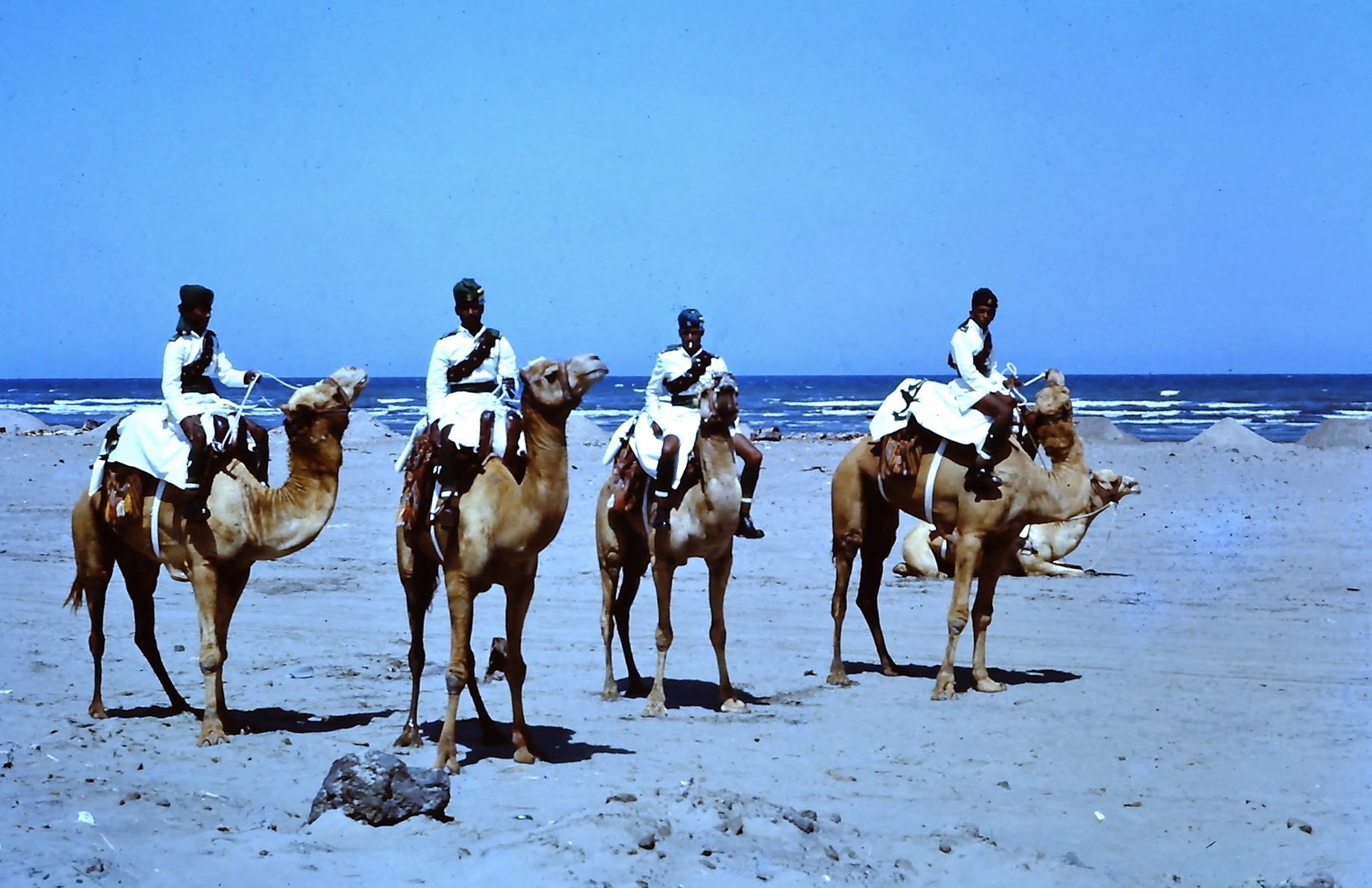

Near the salt pans
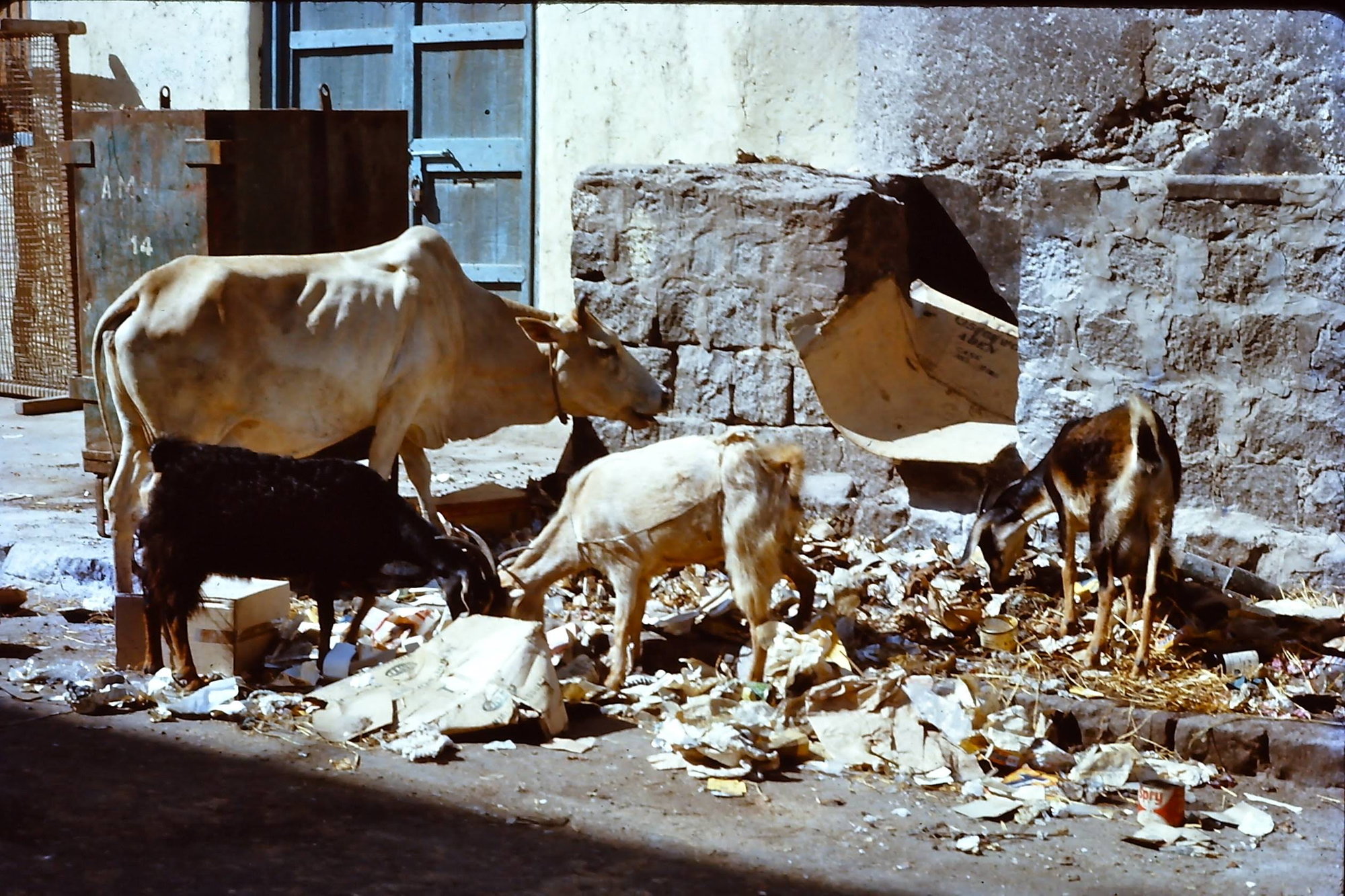
More recycling in the back streets of Crater
Last edited by DeanoP; 21st Dec 2020 at 14:36.
The Cisterns of Tawila, Crater, Aden
Photos taken in 1962 of these ancient cisterns. Wikipedia gives a lot of information, some of which is copied below:
“Regarding the original construction of which nothing is accurately known…” There is indeed little hard evidence and there are few reliable sources of information about the Tanks. One favored hypothesis is that Himyar, a pre-Islamic Arabian kingdom that ruled parts of Yemen from 115 B.C. to 525 A.D., started to build water tanks in the area that eventually became the Cisterns of Tawila. The Himyarites are known to have employed water-catchment tanks in other areas under their rule. The proposed Himyaritic origins of the tanks may help explain a recessed, rectangular area in the Coghlan tank that, according to the Director of the site, could have been used in pre-Islamic times for animal sacrifice (a ritual that the Himyarites were known to perform for a variety of occasions, including drought).[1]
The Tanks were mentioned in some manuscripts after the coming of Islam to Yemen in the 7th century A.D. “Aden has Tanks that store water when the rain falls,” wrote Al-Hamdani in the 10th century.[2] Al-Makdsi, writing three centuries later, also recorded the presence of wells and cisterns in Aden.[3] By the time of the Rasulid dynasty (1229-1454 A.D.), the Tanks had fallen into disrepair. However, the Rassulids recognized the utility of the Tanks and began to restore them.[4] This restoration has led some to claim that the Rassulids built the Tanks, thereby obscuring what are, in all probability, the far more ancient origins of the Tanks. After the Rassulids, the Tanks once again fell into disrepair, damaged by flooding and neglect and filled with the rubble of successive floods.

Cisterns of Tawila 1962
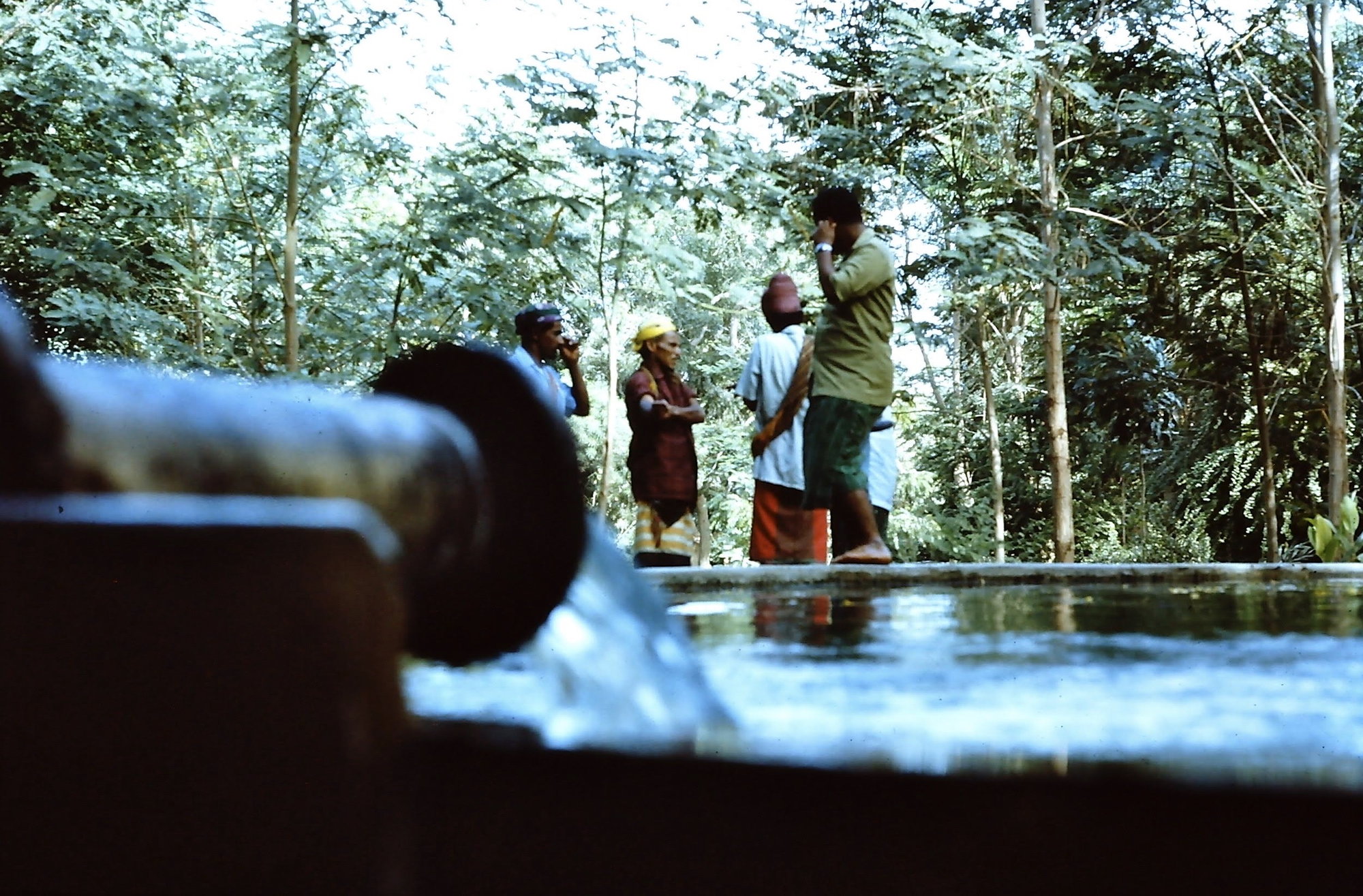
Cisterns of Tawila 1962

Cisterns of Tawila 1962
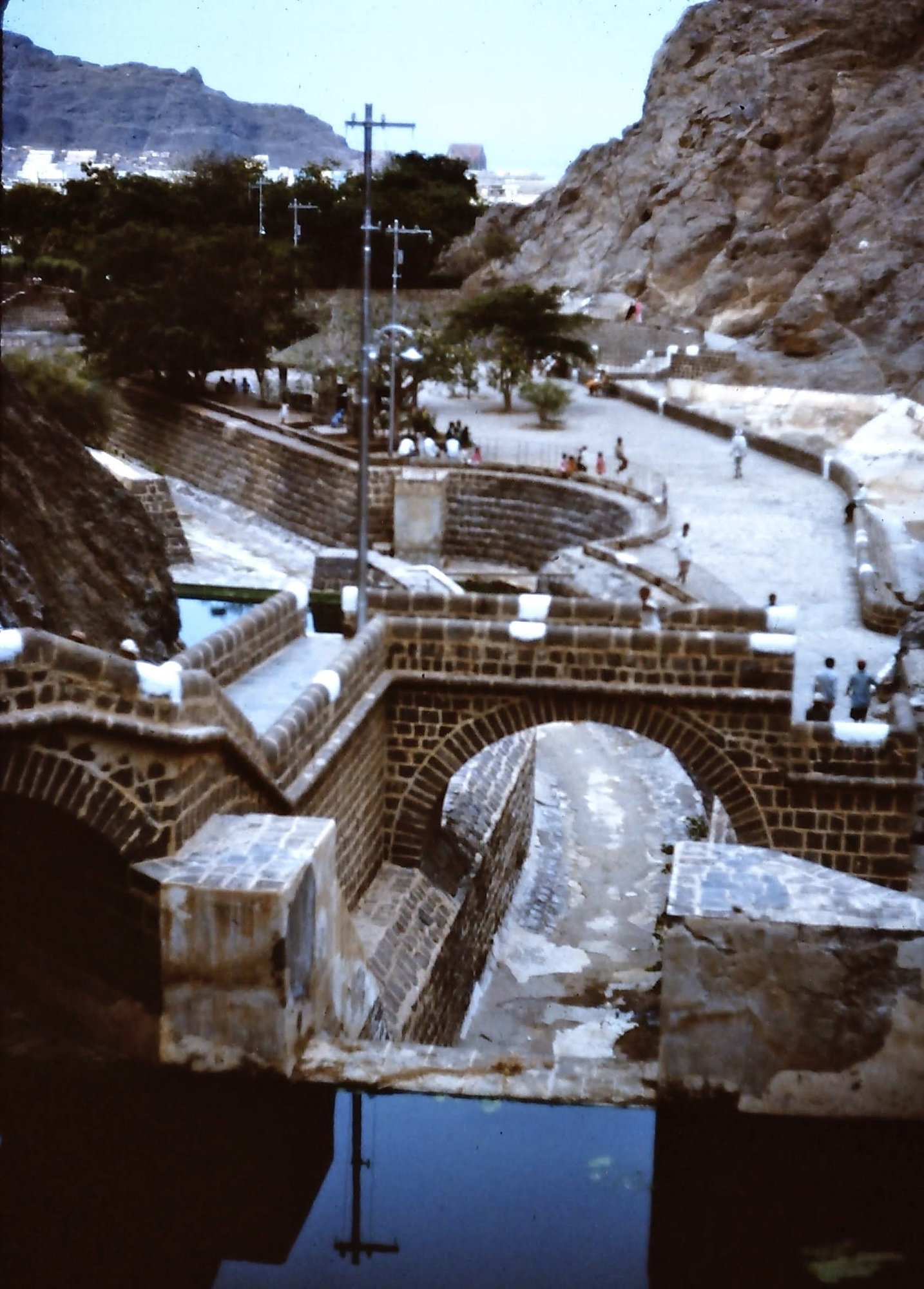
Cisterns of Tawila 1962
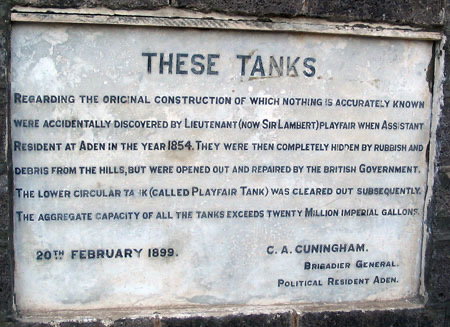
From Wikipedia

Visitors at the Cisterns
“Regarding the original construction of which nothing is accurately known…” There is indeed little hard evidence and there are few reliable sources of information about the Tanks. One favored hypothesis is that Himyar, a pre-Islamic Arabian kingdom that ruled parts of Yemen from 115 B.C. to 525 A.D., started to build water tanks in the area that eventually became the Cisterns of Tawila. The Himyarites are known to have employed water-catchment tanks in other areas under their rule. The proposed Himyaritic origins of the tanks may help explain a recessed, rectangular area in the Coghlan tank that, according to the Director of the site, could have been used in pre-Islamic times for animal sacrifice (a ritual that the Himyarites were known to perform for a variety of occasions, including drought).[1]
The Tanks were mentioned in some manuscripts after the coming of Islam to Yemen in the 7th century A.D. “Aden has Tanks that store water when the rain falls,” wrote Al-Hamdani in the 10th century.[2] Al-Makdsi, writing three centuries later, also recorded the presence of wells and cisterns in Aden.[3] By the time of the Rasulid dynasty (1229-1454 A.D.), the Tanks had fallen into disrepair. However, the Rassulids recognized the utility of the Tanks and began to restore them.[4] This restoration has led some to claim that the Rassulids built the Tanks, thereby obscuring what are, in all probability, the far more ancient origins of the Tanks. After the Rassulids, the Tanks once again fell into disrepair, damaged by flooding and neglect and filled with the rubble of successive floods.

Cisterns of Tawila 1962

Cisterns of Tawila 1962

Cisterns of Tawila 1962

Cisterns of Tawila 1962

From Wikipedia

Visitors at the Cisterns






